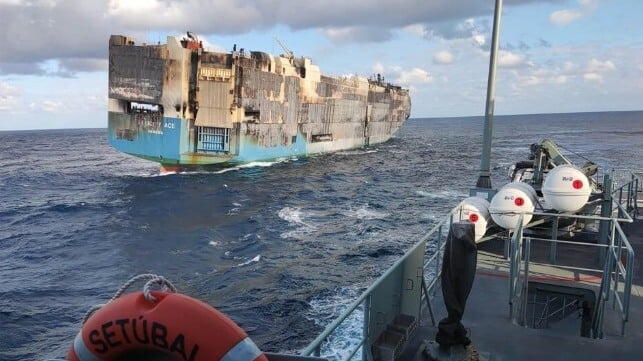The International Union of Marine Insurers (IUMI) has updated its guidelines, warning operators of Pure Car and Truck Carriers (PCTCs) and Ro-Ro passenger ships to be alert to the risk of explosions caused by fires involving electric vehicles (EVs) on board—a concern that had not been sufficiently addressed previously.

Key points:
- The State of Charge (SoC) of batteries within electric vehicles (EVs) being transported by car carriers should be kept as low as practically and technically possible. Currently, no international requirements for SoC in maritime transport have been agreed.
- Currently, no extinguishing agent or system can interrupt the chemical chain reaction occurring in a battery during thermal runaway.
- A comprehensive firefighting strategy must not only consider firefighting itself but also the management of potentially explosive gases that may accumulate during such incidents.
- While there is general agreement that the total energy released by EVs and internal combustion engine vehicles (ICEVs) during a fire is broadly comparable, opinions diverge when it comes to peak temperatures.
- A peculiarity of EVs is the risk of re-ignition, which is higher for a longer period than for ICEVs. Precautionary measures to avoid re-ignition of the traction battery must therefore be taken for an extended period after a fire has been extinguished.
- A challenge specific to roll-on/roll-off (roro) and RoPax vessels is the cargo they carry. EVs such as cars, buses, and excavators are often used vehicles and so may have hidden damages.
- PCTCs present some inherent safety challenges stemming from their unique design characteristics. A specific fire risk onboard PCTCs arises from their large, undivided horizontal fire zones.
- Markings that include basic information about the drivetrain of the vehicles could be useful, e.g., color-coded stickers for EVs, ICEVs, or hydrogen-powered cars.
- Early detection and verification/confirmation of a fire are key to enabling successful firefighting operations. These two steps should not be considered separately but as one single step. The time between detection and confirmation/verification must be reduced to the shortest possible period.
- Onboard PCTCs, the fixed firefighting systems should be applied early, correctly, and safely. Manual firefighting by the crew should be a last resort.
- Seeking external help from professional marine firefighters or salvors is recommended whenever possible.
- To improve its usefulness, the CO₂ firefighting capacity on board PCTCs should be at least doubled.
- An alternative firefighting option for PCTCs would be a total flood high-pressure water mist sprinkler system. It can be activated even with crew present. A major advantage of water-based systems is their cooling effect and the potential for boundary cooling.
- Current ship design and construction limitations must be resolved before this option can be applied broadly.
- Foam-based extinguishing systems onboard PCTCs have notable drawbacks.
- Dedicated training schemes should be developed for seafarers sailing on PCTCs.
- A fundamental obligation for the shipping industry is the proactive exploration of improved onboard firefighting capabilities.
IUMI concluded that the IMO’s SSE Sub-Committee is working on the “Evaluation of adequacy of fire protection, detection and extinction arrangements in vehicle, special category and ro-ro spaces in order to reduce the fire risk of ships carrying new energy vehicles”. The regulatory process will be an opportunity to improve safety requirements making them fit for the new reality of large numbers of alternative fuel vehicles being carried on board vessels.
Current limitations in fire detection and protection ought to influence future ship designs and highlight the importance of early detection of deviations in an EV’s battery pack, containment measures, crew training and drills. Time between detection and confirmation/verification must be reduced to the shortest possible period. It is a constant task for the shipping industry to advance and implement improved fire safety measures.
It is also important to account for EV technology that is constantly evolving. Fire safety on ships must not be the sole responsibility of the shipping industry. In their role as shippers or charterers, car and battery manufacturers also have a role to play in loss prevention by offering guidance and solutions to enhance safety onboard.
Any regulatory changes must be able to cover technological advancements. At the same time, it is important to recognize that it will take time to fill the current gaps in the regulatory landscape. Therefore, all stakeholders involved in the carriage of EVs onboard ships need to collaborate, share knowledge, learn from each other, and implement and further develop best practices in line with the latest research.
Further developments can be anticipated, hence the safe ocean and short sea carriage of EVs remains an area in which underwriters need to maintain their awareness.
The International Union of Marine Insurance (IUMI) represents 42 national and marine market insurance and reinsurance associations. Operating at the forefront of marine risk, it gives a unified voice to the global marine insurance market through effective representation and lobbying activities. As a forum for the exchange of ideas and best practice, IUMI works to raise standards across the industry and provides opportunities for education and the collection and publication of industry statistics. IUMI is headquartered in Hamburg and traces its roots back to 1874.
Given the significant risks associated with transporting electric vehicles, two shipping companies have announced suspensions of EV shipments this year: Alaska Marine Lines, a subsidiary of Lynden, and U.S.-based Matson.


